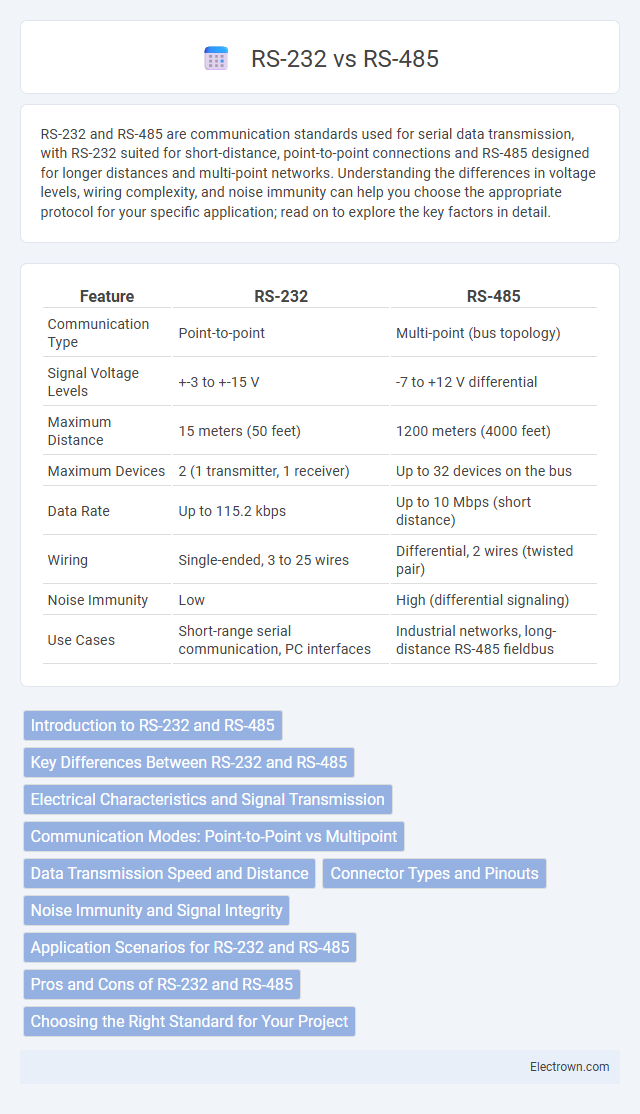RS-232 and RS-485 are communication standards used for serial data transmission, with RS-232 suited for short-distance, point-to-point connections and RS-485 designed for longer distances and multi-point networks. Understanding the differences in voltage levels, wiring complexity, and noise immunity can help you choose the appropriate protocol for your specific application; read on to explore the key factors in detail.
Table of Comparison
| Feature | RS-232 | RS-485 |
|---|---|---|
| Communication Type | Point-to-point | Multi-point (bus topology) |
| Signal Voltage Levels | +-3 to +-15 V | -7 to +12 V differential |
| Maximum Distance | 15 meters (50 feet) | 1200 meters (4000 feet) |
| Maximum Devices | 2 (1 transmitter, 1 receiver) | Up to 32 devices on the bus |
| Data Rate | Up to 115.2 kbps | Up to 10 Mbps (short distance) |
| Wiring | Single-ended, 3 to 25 wires | Differential, 2 wires (twisted pair) |
| Noise Immunity | Low | High (differential signaling) |
| Use Cases | Short-range serial communication, PC interfaces | Industrial networks, long-distance RS-485 fieldbus |
Introduction to RS-232 and RS-485
RS-232 is a standard for serial communication primarily used for short-distance, point-to-point connections, supporting data transmission speeds up to 20 kbps over distances typically less than 50 feet. RS-485 offers a robust multi-point data bus system that supports longer cable lengths up to 4,000 feet and higher data rates reaching 10 Mbps, ideal for industrial environments requiring noise immunity. Understanding the key differences between RS-232 and RS-485 enables you to select the appropriate protocol for your serial communication needs, balancing range, speed, and network complexity.
Key Differences Between RS-232 and RS-485
RS-232 supports point-to-point communication with a maximum cable length of 15 meters and data rates up to 20 kbps, while RS-485 enables multi-point communication over distances up to 1,200 meters and data rates reaching 10 Mbps. RS-232 uses single-ended signaling, making it more susceptible to noise, whereas RS-485 employs differential signaling for improved noise immunity in industrial environments. RS-485 supports up to 32 devices on a bus, offering robust network scalability compared to the limited device support of RS-232.
Electrical Characteristics and Signal Transmission
RS-232 uses single-ended signaling with voltage levels ranging from +-3V to +-15V, ideal for short-distance communication up to 15 meters, but is susceptible to noise and signal degradation. RS-485 employs differential signaling with voltage levels around +-1.5V to +-5V, supporting long-distance communication up to 1,200 meters and enhanced noise immunity in industrial environments. The differential nature of RS-485 allows multiple devices on a bus topology, enabling robust and reliable signal transmission over extended cable lengths.
Communication Modes: Point-to-Point vs Multipoint
RS-232 supports point-to-point communication, enabling direct data exchange between two devices over short distances typically up to 15 meters. RS-485 facilitates multipoint communication, allowing multiple devices (up to 32 or more) to share a common bus over longer distances up to 1200 meters, ideal for industrial networks. The differential signaling in RS-485 enhances noise immunity and enables reliable communication in complex, multi-device environments.
Data Transmission Speed and Distance
RS-232 supports data transmission speeds up to 115.2 Kbps over distances typically limited to 15 meters, making it suitable for short-range communication. RS-485 enables higher speeds up to 10 Mbps while maintaining reliable data transmission over distances up to 1,200 meters due to differential signaling. The enhanced noise immunity and longer cable lengths of RS-485 make it ideal for industrial environments requiring robust, long-distance communication.
Connector Types and Pinouts
RS-232 typically uses DB9 or DB25 connectors with defined pinouts for serial communication, offering point-to-point data transfer suitable for short-distance connections. RS-485 employs terminal blocks or RJ45 connectors with differential signaling pins, supporting multi-point communication and longer cable lengths in industrial environments. Your choice depends on device compatibility and the required network topology for reliable data exchange.
Noise Immunity and Signal Integrity
RS-485 offers superior noise immunity and signal integrity compared to RS-232, making it ideal for industrial environments and long-distance communication. The differential signaling used in RS-485 reduces electromagnetic interference, ensuring accurate data transmission over distances up to 1,200 meters. Your systems benefit from enhanced reliability and reduced signal degradation when choosing RS-485 for robust communication needs.
Application Scenarios for RS-232 and RS-485
RS-232 is commonly used in point-to-point communication for short distances, such as connecting a computer to a modem or serial device within a single room or building. RS-485 excels in industrial and commercial environments requiring multi-drop networks over long distances, supporting up to 32 devices on a single bus with robust noise immunity. Applications for RS-485 include automation systems, building management, and sensor networks where reliable data transmission over extended cables and multiple nodes is critical.
Pros and Cons of RS-232 and RS-485
RS-232 offers simplicity and ease of use for short-distance, point-to-point communication with low cost and widespread compatibility but suffers from limited range (up to 50 feet) and single-device connection. RS-485 supports long-distance communication (up to 4,000 feet) and multi-point connections with robust noise immunity, making it ideal for industrial environments, yet it requires more complex wiring and termination resistors. Choosing between RS-232 and RS-485 depends on factors like distance, network size, and environmental interference.
Choosing the Right Standard for Your Project
RS-232 is ideal for short-distance, point-to-point communication typically under 50 feet, making it suitable for simple device connections with single-ended signaling. RS-485 supports multi-point networks over longer distances up to 4,000 feet using differential signaling, which reduces noise and allows multiple devices on the same bus. Selecting between RS-232 and RS-485 depends on project requirements such as communication range, network topology, and noise immunity.
RS-232 vs RS-485 Infographic

 electrown.com
electrown.com